
PANELISTS

JB and Sabre in rehearsal for the performative lecture: Performance Spaces for Domestic Animals, 2005. (photo: Joanne Bristol)
Artist Statement
My art practice is invested in understanding relationships between nature
and culture, and between art, science and history. In the past I have
created installations, performances, videos and bookworks looking at the
history of science from feminist perspectives.
Most recently I have been examining the possibilities of working through performative interventions to engage publics in considering the politics and poetics of human-animal relationships. I am looking at how humans hold animals – within ideological and architectural structures – as well as how different species can have reciprocal influence on each other. I am especially interested in doing this through focusing on perception, affect and the haptic.
Though live exchanges with people (and other animals) are central to
my current work, I also document performances with video, photography
and writing. Exchange, storytelling, humour and play are aspects of my
work through which I try to engage with audiences. As well as being an
artist and writer for the past fifteen years, I also am an art educator
and curator. I continue to seek out projects involving interdisciplinary
collaboration, and those that have the potential to build links between
different communities and different ways of knowing.
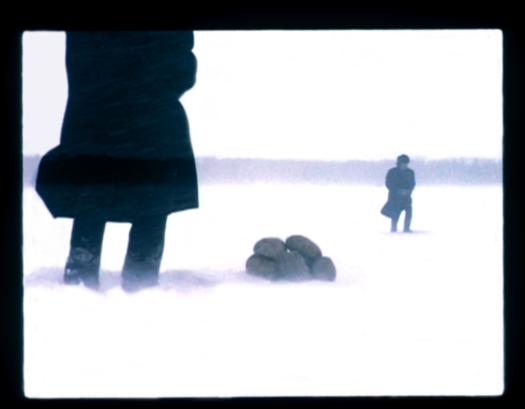
Untitled, Digitally manipulated video stills, 2008
Leah Decter is a visual artist whose practice includes installation, sculpture, video and performance. Her work has been exhibited in Canada since 1993, with recent work exhibiting in the US and touring internationally. Leah has worked as a curator, educator and mentor, and has been active in public and socially-engaged work since 1999. She currently makes her home in Winnipeg, having returned in 2006 after many years in Toronto and Vancouver.
Artist Statement
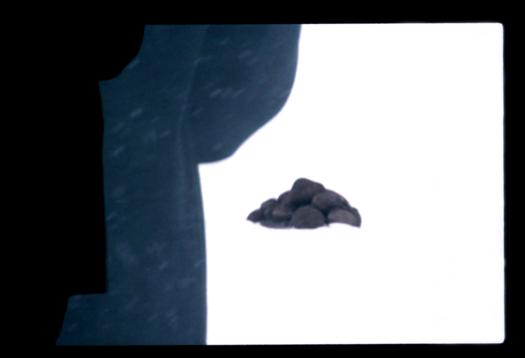
Untitled, Digitally manipulated video stills, 2008
Jennifer Delos Reyes is a Canadian artist originally from Winnipeg, MB. Her theoretical and studio research interests include: relational aesthetics, group work, interactive media and artists' social roles. She has exhibited videos, installations, and site-specific participatory work across North America and Europe. In 2006 she completed an intensive workshop, Come Together: Art and Social Engagement, at The Kitchen in New York. She has received numerous grants and awards including a Social Sciences and Humanities Research Council of Canada Masters Grant. In 2007 Jennifer organized a conference on socially engaged art practices titled Open Engagement: Art After Aesthetic Distance. In the fall of 2008 she will join the faculty at Portland State University in the Social Practice Program with Harrell Fletcher.
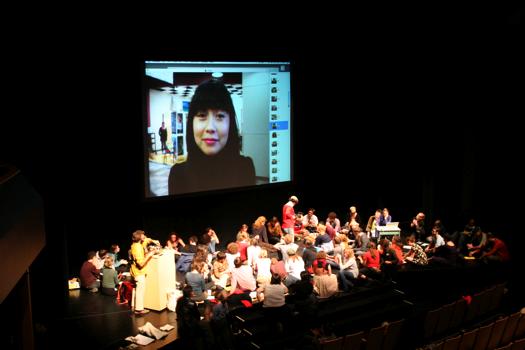
Image of myself on screen at Future Farmers Bingo, 2007, Regina, SK.
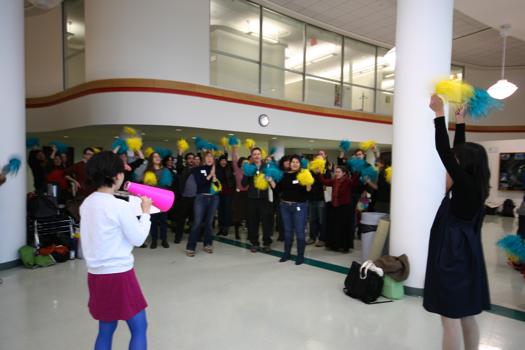 Group
Cheer, Photo of group cheer of Open Engagement, 2007
Group
Cheer, Photo of group cheer of Open Engagement, 2007 Detail of Kokum Mamama, 2006, KC Adams, Installation
Detail of Kokum Mamama, 2006, KC Adams, Installation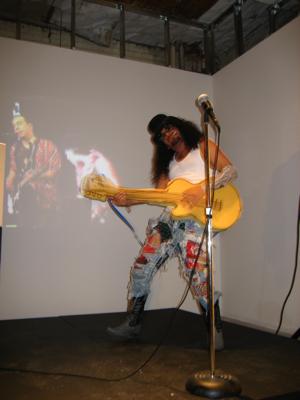 Roger
Crait finding his inner Rockstar at Rockstars & Wannabes, September,
2007
Roger
Crait finding his inner Rockstar at Rockstars & Wannabes, September,
2007 Curatorial Statement
As I navigate within and around the local, the global, cultural codes,
my own hybridity, and my rural and urban existences, finding ways to engage,
be engaged, be present, while having some sort of presence is a priority
in my curating.
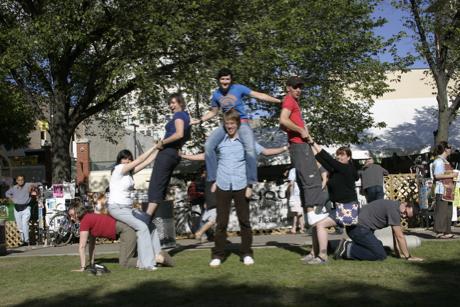 Pyramid Vivant, Performance documentation, 2005
Pyramid Vivant, Performance documentation, 2005 Artist / Curatorial Statement
In all my endeavours, I seek to communicate ideas based in a fundamental
understanding that everything is political and should be treated so. When
considering community-based art actions, I think it is important to understand
the various dynamics that come into play: socio-economical, political,
and personal. In my experience, the best outcome for an exhibition or
presentation is the resulting dialogue.
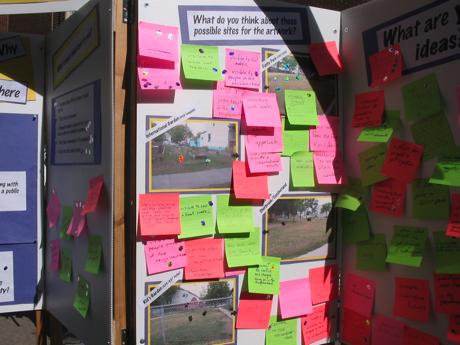 Community
consultation for Leah Decter and Spence Neighbourhood Association's WITH
ART project. Photo by Leah Decter
Community
consultation for Leah Decter and Spence Neighbourhood Association's WITH
ART project. Photo by Leah DecterTricia Wasney is public art manager for the Winnipeg Arts Council. She has worked in Winnipeg's art community for many years in various roles of program co-ordinator, project manager, board member, juror and artist/writer. She holds a Bachelor of Arts degree in Film Studies and a Master of Landscape Architecture degree, both from the University of Manitoba. She was hired by the Winnipeg Arts Council in May 2002 to develop the public art policy that was ultimately adopted by Winnipeg's City Council two years later. In January 2004 she was appointed Manager-Public Art and now oversees a steadily growing public art program that includes art commissions, artist-in-residence projects and a community-based program entitled WITH ART.
STATEMENT:
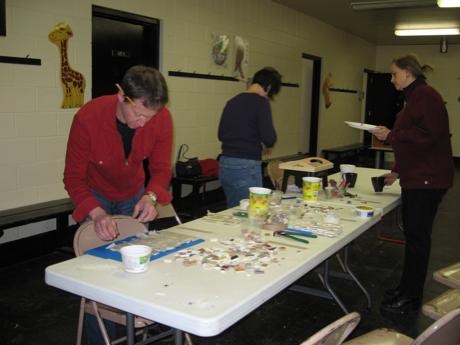 Artist
Dimitry Melman working with members of the Elwick Community on a WITH
ART mosaic project. Photo by Tricia Wasney
Artist
Dimitry Melman working with members of the Elwick Community on a WITH
ART mosaic project. Photo by Tricia Wasney"We wanted to create a community art program that would be truly
collaborative and meaningful...we were not interested in art as decoration
or in serving a purely functional role. We wanted artists and community
groups to use the art process to work through concerns and ideas. I think
in being strong in our convictions and in the criteria for the program,
we attracted equally committed and strong community groups for the WITH
ART program who really understood and embraced the concept. As an arts
administrator and as an artist and writer myself, I am really interested
in notions of home and place. This must be something that resonates with
many of us since when I think about it, many of the projects explored
through WITH ART are about place (or displacement) and home (or homelessness)
and all the evershifting terrain in between."
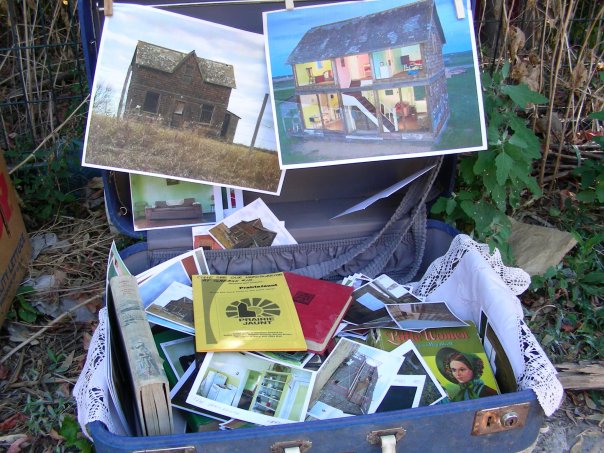 Heather Benning, "The Dollhouse" from PrairieJaunt: Southwestern Manitoba (2007)
Heather Benning, "The Dollhouse" from PrairieJaunt: Southwestern Manitoba (2007)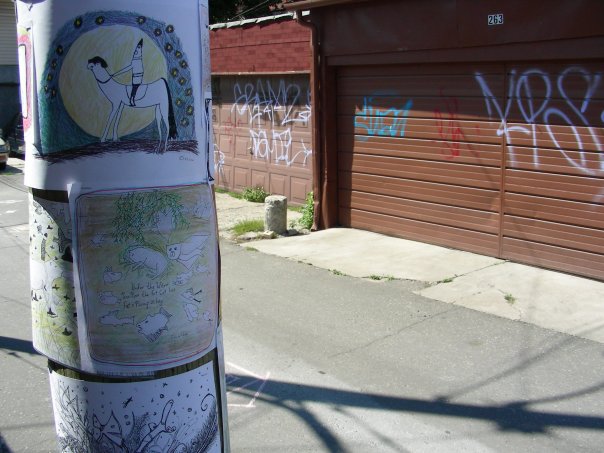 Erica
Lowe, "The Mayor of Harding" from PrairieJaunt: Toronto (2007)
Erica
Lowe, "The Mayor of Harding" from PrairieJaunt: Toronto (2007)Curatorial Statement:
Jenny Western's curatorial practice is engaged with work by emerging,
rural, and Aboriginal artists. An interest in relational aesthetics, the
role of the participant-observer in art and the art gallery as a social
space has been the driving force behind many of her exhibitions, including
the "PrairieJaunt" project. Co-organized with artist/curator
Amber Andersen, "PrairieJaunt" attempted to bridge the gap between
rural and urban art scenes. Site-specific and large-scale work by Shirley
Brown, Heather Benning, Erica Lowe, Libby Weir and Amber Andersen were
visited in a day-long "art crawl" throughout Southwestern Manitoba
while the artists sent miniature versions of their work to Toronto to
participate in the garage-based arts festival AlleyJaunt. "PrairieJaunt"
is an exercise in the translatability and exchange of identity, location,
and culture; an investigation that remains ongoing in Jenny's curatorial
practice.
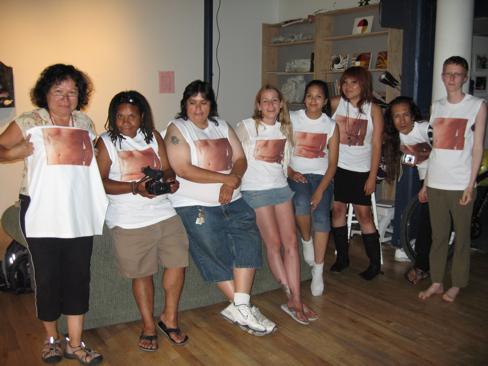 Shelley
Niro in a workshop with Crossing Communities members, 2006
Shelley
Niro in a workshop with Crossing Communities members, 2006Edith Regier is the founder and current Artistic Director of the Crossing Communities Art Project. She holds an MFA from the University of Houston. In 1995 she founded the Portage Art Project at the Portage Women's Correctional Centre that in 2002 evolved into the city based Crossing Communities. Her interest is in advocating the use of the imagination and culture as a means to create networks of friendship to work towards social and economic transformation.
Statement:
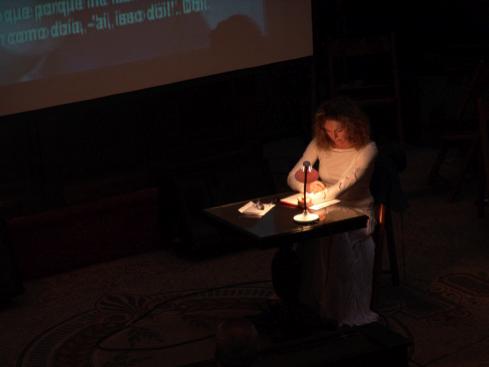 Edith
Regier, In Memory of Darcie Hall performance, Brazil 2005
Edith
Regier, In Memory of Darcie Hall performance, Brazil 2005











